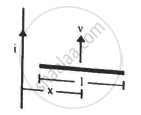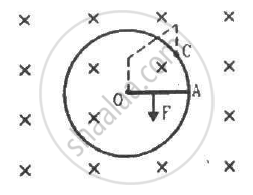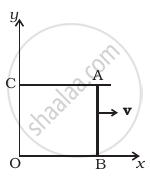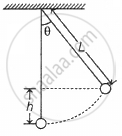Advertisements
Advertisements
प्रश्न
A 20 cm long conducting rod is set into pure translation with a uniform velocity of 10 cm s−1 perpendicular to its length. A uniform magnetic field of magnitude 0.10 T exists in a direction perpendicular to the plane of motion. (a) Find the average magnetic force on the free electrons of the rod. (b) For what electric field inside the rod, the electric force on a free elctron will balance the magnetic force? How is this electric field created? (c) Find the motional emf between the ends of the rod.
उत्तर
Given:-
Length of the rod, l = 20 cm = 0.2 m
Velocity of the rod, v = 10 cm/s = 0.1 m/s
Magnetic field, B = 0.10 T
(a) The force on a charged particle moving with velocity v in a magnetic field is given by
\[\overrightarrow{F} = q\left( \overrightarrow{v} \times \overrightarrow{B} \right)\]
F = qvB sin θ
Here,
θ = 90o
Now,
F = (1.6 × 10−19) × (1 × 10−1) × (1 × 10−1)
= 1.6 × 10−21 N
(b) The electrostatic force on the charged particle is qE.
Here,
qE = qvB
⇒ E = (1 × 10−1 ) × (1 × 10−1)
= 1 × 10−2 V/m
It is created because of the induced emf.
(c) Motional emf between the ends of the rod, e = Bvl
⇒ e = 0.1 × 0.1 × 0.2
= 2 × 10−3 V
APPEARS IN
संबंधित प्रश्न
Figure shows a straight, long wire carrying a current i and a rod of length l coplanar with the wire and perpendicular to it. The rod moves with a constant velocity v in a direction parallel to the wire. The distance of the wire from the centre of the rod is x. Find the motional emf induced in the rod.

Consider the situation shown in the figure. Suppose the wire connecting O and C has zero resistance but the circular loop has a resistance Runiformly distributed along its length. The rod OA is made to rotate with a uniform angular speed ω as shown in the figure. Find the current in the rod when ∠ AOC = 90°.

A metal disc of radius 30 cm spins at 20 revolution per second about its transverse symmetry axis in a uniform magnetic field of 0.20 T. The field is parallel to the axis of rotation. Calculate
(a) the area swept out per second by the radius of the disc
(b) the flux cut per second by a radius of the disc
(c) the induced emf between the axle and rim of the disc.
Mechanical force per unit area of a charged conductor is ______
A cycle wheel of radius 0.6 m is rotated with constant angular velocity of 15 rad/s in a region of magnetic field of 0.2 T which is perpendicular to the plane of the wheel. The e.m.f generated between its center and the rim is, ____________.
A wire of length 50 cm moves with a velocity of 300 m/min, perpendicular to a magnetic field. If the e.m.f. induced in the wire is 2 V, the magnitude of the field in tesla is ______.
The emf induced across the ends of a conductor due to its motion in a magnetic field is called motional emf. It is produced due to magnetic Lorentz force acting on the free electrons of the conductor. For a circuit shown in the figure, if a conductor of length l moves with velocity v in a magnetic field B perpendicular to both its length and the direction of the magnetic field, then all the induced parameters are possible in the circuit.

A conducting rod of length l is moving in a transverse magnetic field of strength B with velocity v. The resistance of the rod is R. The current in the rod is ______.
The emf induced across the ends of a conductor due to its motion in a magnetic field is called motional emf. It is produced due to magnetic Lorentz force acting on the free electrons of the conductor. For a circuit shown in the figure, if a conductor of length l moves with velocity v in a magnetic field B perpendicular to both its length and the direction of the magnetic field, then all the induced parameters are possible in the circuit.

A bicycle generator creates 1.5 V at 15 km/hr. The EMF generated at 10 km/hr is ______.
An e.m.f is produced in a coil, which is not connected to an external voltage source. This can be due to ______.
- the coil being in a time varying magnetic field.
- the coil moving in a time varying magnetic field.
- the coil moving in a constant magnetic field.
- the coil is stationary in external spatially varying magnetic field, which does not change with time.
A magnetic field B = Bo sin ( ωt )`hatk` wire AB slides smoothly over two parallel conductors separated by a distance d (Figure). The wires are in the x-y plane. The wire AB (of length d) has resistance R and the parallel wires have negligible resistance. If AB is moving with velocity v, what is the current in the circuit. What is the force needed to keep the wire moving at constant velocity?

A rectangular loop of wire ABCD is kept close to an infinitely long wire carrying a current I(t) = Io (1 – t/T) for 0 ≤ t ≤ T and I(0) = 0 for t > T (Figure). Find the total charge passing through a given point in the loop, in time T. The resistance of the loop is R.

A rod of mass m and resistance R slides smoothly over two parallel perfectly conducting wires kept sloping at an angle θ with respect to the horizontal (Figure). The circuit is closed through a perfect conductor at the top. There is a constant magnetic field B along the vertical direction. If the rod is initially at rest, find the velocity of the rod as a function of time.

A simple pendulum with a bob of mass m and conducting wire of length L swings under gravity through an angle θ. The component of the earth's magnetic field in the direction perpendicular to the swing is B. Maximum emf induced across the pendulum is ______.
(g = acceleration due to gravity)

Derive an expression for the total emf induced in a conducting rotating rod.
A magnetic flux associated with a coil changes by 0.04 Wb in 0.2 second. The induced emf with coil is ______.
An aircraft of wing span of 60 m flies horizontally in earth’s magnetic field of 6 × 10−5 T at a speed of 500 m/s. Calculate the e.m.f. induced between the tips of the wings of the aircraft.
